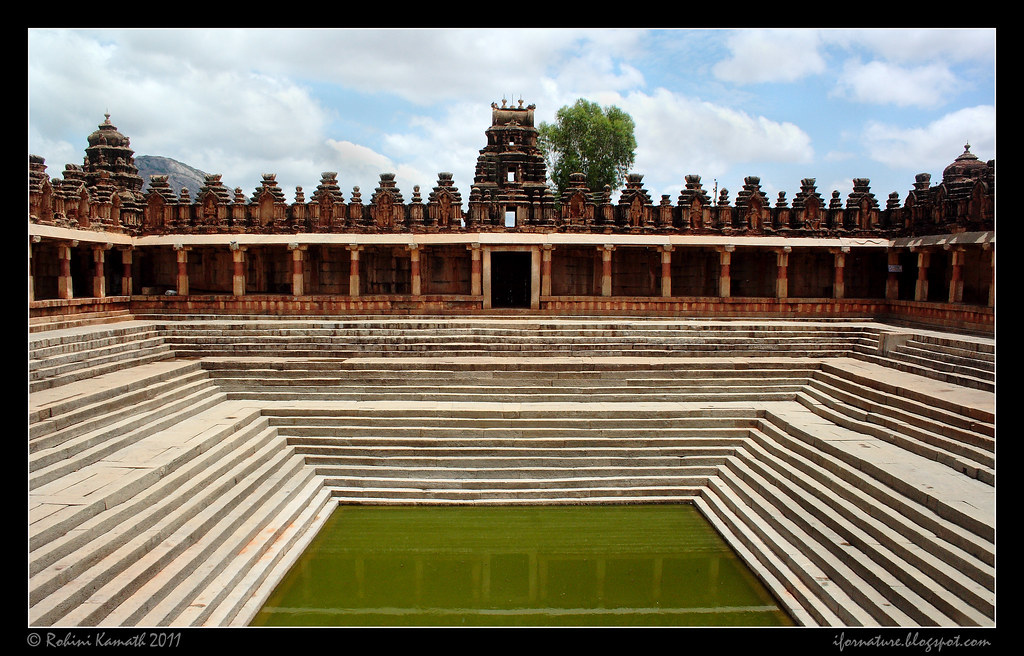
The Stepped Tank
When I first saw this online, I knew we had to go here. I was beside myself when I found it to be just a stones throw away, at the foot of Nandi Hills. I chanced upon this while looking for ancient architecture to photograph within driving distance from Bangalore. I learnt of it from this blog - A Protest of Romance.
Finding it was easy, since we are regular visitors to Nandi Hills, we also found a surprise along the way. This temple is very much in use and accordingly you need to leave your footware outside on a shoe rack. The grounds are extensive and the tall trees offer excellent shade and the lawns are very comfy should you need it for some quite contemplation. Happily there are no beggars or hawkers. Parking and entry is free.
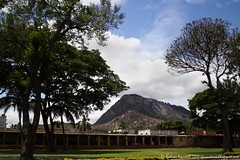 | 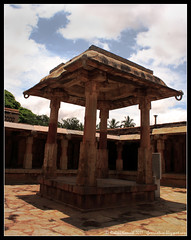 | 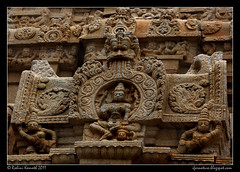 |
History and Info
There is a board by the ASI that provides details at the entrance. The temple was commissioned by Queen Manikabbe (the board calls her Ratnavalli) of the Bana King - Bana Vidhyadhara sometime before AD806 ( the board says 810 AD). And who am I to question the all knowing board you ask? Well, I get my reference from here.
This is a good size temple complex, having 3 shrines, the North to Bhoganandishwara, South to Arunachaleshwara and a small one for Umamaheshwara. I googled extensively to find the story of origin of the names of these forms, but didnt come up with any concrete answers. I'm going to hazard a guess that Arunachaleshwara refers to the Loard of the Arunachal Mountain ( in Thiruvanamalai, TN ). Attached to the small shrine of Umamaheshwara is the famous Kalyanamantapa of black stone with massive pillars and incredibly intricate carvings.
The board tells us helpfully that each temple consists of a garbhagriha, sukanasi and a navaranga. Hmmm. But what does that mean exactly?
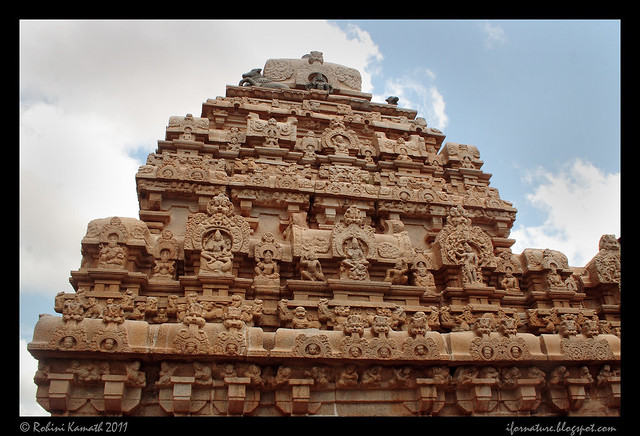
Important terms you should know
Garbhagriha - Inner sanctum - The garbhagriha of each temple is a sanctified space in the temple. It is where the deity is placed and is the religious center of the temple.
Sukanasi - the space between the garbhagrha and the navaranga, is a small thick walled chamber without windows, its open doorways leading to the garbhagriha and the navaranga. The sukanasi, identified with the antarala, is the same size as the garbhagriha.
Navaranga - The navaranga, generally referred to as the mandapa in Hindu temples, is a hall (ranga) divided into nine (nava) sections. The central section of the navaranga is generally bigger than the others and slightly raised, the latter feature being a particularly notable characteristic of the Hoysala temples. This is the place for singing and dancing in honor of gods.
The Big Fat Divine Wedding
Weddings are always a big deal. But when gods get married, they are truely spectacular. The mortals have wedding albums and videos, but if you are an important god, you get to have stuff like this made for you! I was stunned by the friezes that depict the marriage of Lord Shiva with Goddess Parvati, it was unlike anything I've seen before.
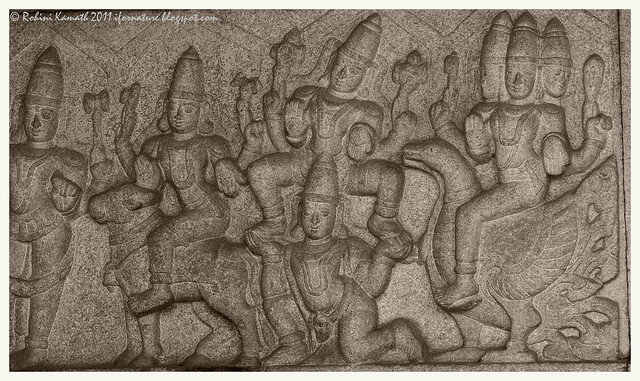
Here, the tridev are depicted on their respective mounts ( I admit I was a bit foxed by Garuda's appearance, I wish they had depicted him as the eagle instead of the human form ). Shiva on Nandi, Vishnu with Garuda and Brahma on the Swan.
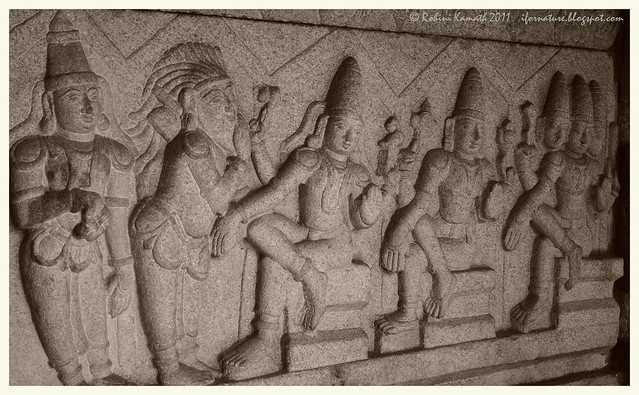
I'm guessing that they are being seated on arrival and are being welcomed by their host. I'm not sure who the man with the flowing hair is. Perhaps a priest?
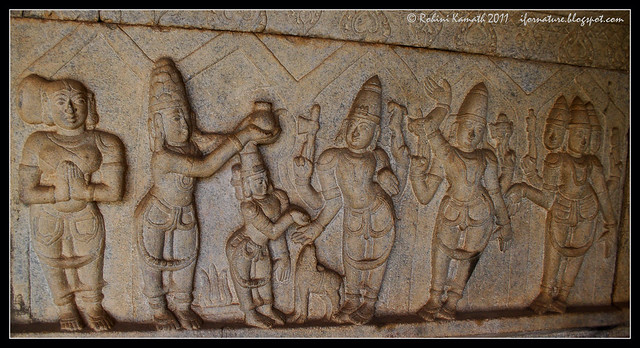
Kanyadan (giving away the bride) performed by the parents of Parvati. I'm not sure what the animal is doing there. Looks too small to be nandi. Im not quite sure what animal it is. If you know, please leave a comment, I would dearly like to know. Notice the sacred fire in the back, just behind Parvati.
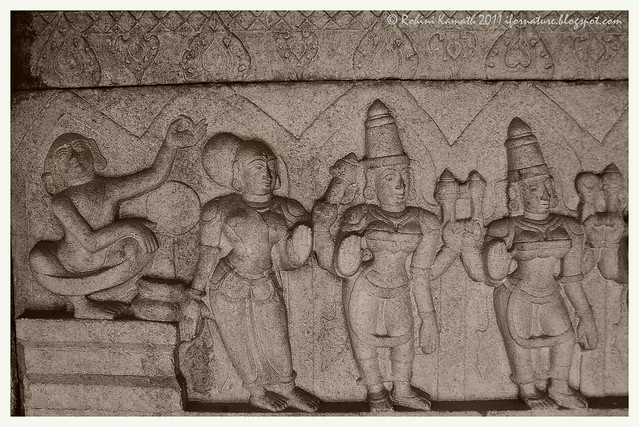
Priest seated on a platform, performing the marriage
Do also check this blog - A Turquoise Cloud for some photos of the sanctum that I couldn't photograph due to a maha yagna in progress. The details and mythology behind the wedding is also very well described and useful to appreciate the art for someone unfamiliar with hindu mythology. Just one correction from myside to the story. Kamadeva - god of love did not die, like all gods he is immortal, he lost his form and became formless, burnt by Shiva's third eye and later took form as Pradyumn son of Krishna and Rukmini. For details - see wikipedia
I was surprised to learn that weddings of mere mortals can also be conducted here (using the Vasantha Kalyanamantapa). If you want to get married here, helpful details at the end of this post.
While its a reletively unknown place, its certainly not empty; there were a few devotees, but there were no tourists other than us. The lone guide ( yes, there is always an annoying guide ) pounced on us like we were manna from heaven. He spoke only kannada to the delight of Keshav who happily left it to me to deal with him. After enduring him for 30 min, I paid him to get rid of him. If anything, these guys are a pain and should be prohibited from annoying people who have come to explore on their own. The guide told me that the black stone kalyanamantap cannot be photographed but I see photos of it all over the internet.

The god is in the details
That phrase could not be more apt for this glorious structure (and I mean that both literally and figuratively). The intricacy of the carvings here speak of great attention of detail. I wont say much more, I took a lot of pictures, here are a few. I assure you though, none do justice to this monument. For a building that is 1200yrs old, it is in terrific shape. (for the sake of comparison, the famous Angkor Wat of Cambodia is just 800yrs old)
 Lakshmi & Ganesh | 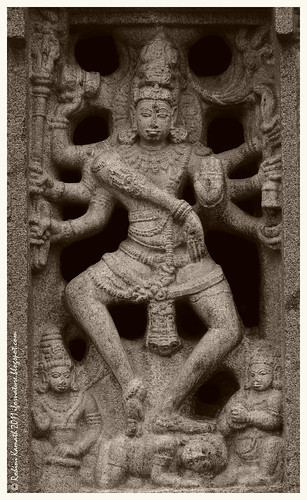 Shiva as Nataraj | 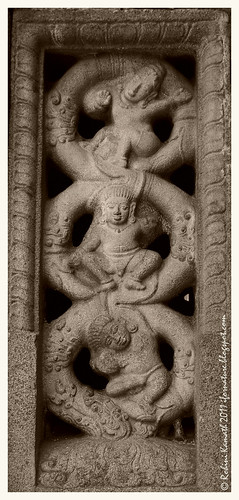 3 Figures |
Almost every conceivable surface is covered with tiny faces, each one having different expressions, every edge is covered with small armies of animals and little figures. There is very little damage to any structure, I guess its because this temple is very much in use and hence well maintained. A refreshing change in this temple I found was the varieties of style. While the familiar hoysala tiger makes his presence felt every now and then, I thought the temple as a whole did not have a rigid adherence to the style. A little research on coming home revealed why, the temple was progressively built over the years by the various rulers, the Banas, the Cholas, the Hoysalas, the Gangarasas, the Pallavas and the rulers of Vijayanagara. A rare case of multiple cooks who over time made a wonderfully inspired broth.
To compare styles, an example of Pallava architecture is Mahabalipuram built during the reign of Narasimha Varman I (Mamalla) (630-668 AD). The rider on the half tiger-horse pillars are exactly similar to the vijayanagara style and are seen all over Hampi ( the hampi blog is a work in progress ). Here though, the temple doesn't rest on the backs of elephants as it does in Somnathpura, it is supported instead on the backs and shoulders of short, plump and rather stressed looking humanoid creatures. ( I have a lot of photos and they will be added to flickr )
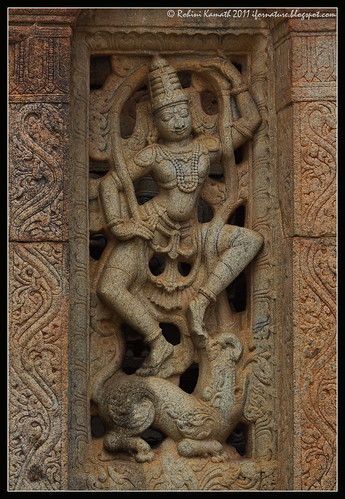 Celestial Dancer |  Who is this? And who is on his shoulder? |
Along with the peacefully seated gods and goddesses and the dancing deities, there is also ample depiction of the wrathful side of the gods. Below is seen, Vishnu in Narsimha avatar, making short work of Hiranyakashyap ( daddy of Prahlad ). The other with the 6 arms, is I guess, Shiva in one of his more fearsome forms spearing some baddie. I dont know who it is at the moment, and welcome any suggestions on who it may be.
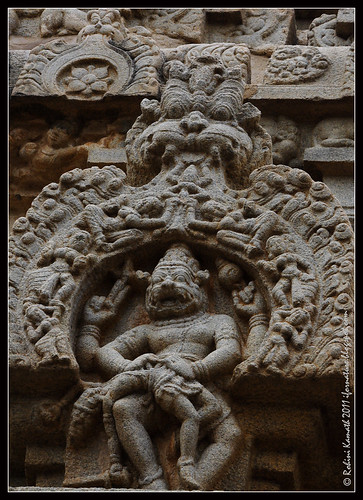 Vishnu as Narasimha | 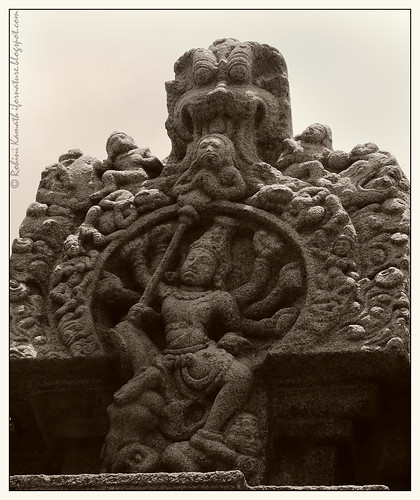 Id Help Pls |
The shrine to Uma-maheshwara is the most beautiful and the only one we didnt get a good look at. There was some restoration work in progress so part of the narrow walk way around the inner sactum was blocked by pipes. The front was occupied by devotees performing some yagna, and no photographs could be taken. It was pretty dark as well. The walls surrounding the sanctum have friezes similar to the wedding depictions in style, though I thought they were more pronounced, almost popping out of the walls.
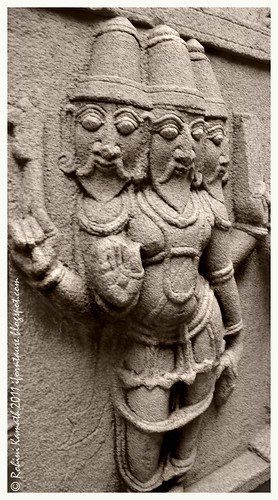 Brahma |  The flowing haired guy - who is he? |
There was also a God with two heads depicted on the other side of the wall here ( Im guessing its Agni - each head representing his two sides, destructive and beneficial ). However, at another part of the temple, i saw that he is depicted with only 1 head but the presence of the Ram next to him ( this mount ) confirms that its him ). Its discovering these little things for yourself which really helps you appreciate the trouble the artists have taken to ensure the meanings are conveyed to their audience. This is not a place to hurry. Slow down, and take your time to soak it up.
Getting there
Those familiar with Nandi Hills know that we turn left to climb up towards the hill. To reach this place, go right instead. Follow the scenic road till you reach the temple ( dont worry, there are boards ). Park in front of the whitewashed outer compound. Tripods are not allowed inside the temple. You can leave it in the temple office if you happen to have brought it in with you.
Tips:
Wear dark colored socks. Carry cash to pay off the guide. Reach early, preferably before the devotees, guides and purohits and who ever else comes there.
Admiring ancient art is hungry work, and when the tummy rumbles, you need to head up the Nandi Hills and eat at the restaurant there. Or you can try the resorts at the bottom of the hills ( We haven't tried them, so if you have please let me know )
If you liked this place, you may also like Lepakshi ( a place we havent been to yet, but its definitely on our agenda ), If you've been there, please leave a link to your blog, I need to do research :)
Address and Info to get married here
Sri BhogaNandiShwera Swami Devalaya
Nandigrama, Nandi Village, Chikkabalapura
Contact Mr. Vijay Ph. No. – 09341170852
Source for the glossary of terms : A Study of Spatial Composition of the Hoysala Temples - PDF






13 comments:
Hi ya, you can visit the post at my blog for lepakshi. Don't forget to stop by at vidurashwatha. http://digital-hype.blogspot.com/2009/08/lepakshi.html
Nice writeup. Must go here sometime! You can visit my post on Lepakshi at http://weekendtravels.wordpress.com/2010/10/
awesome sauce!
I will visit this place soon. this post was more candid than your other posts.
Nice post, never been here though!
Shows how aware we are of the places so close by yet so distant!
Wonderful photos..I do like your blog a lot and am following..!
Very Very Informative and Excellent Photos...
Regards,
Swaminathan N
Facebook: Swaminathan Natarajan Photography
Fickr:Swami9
Blog:http://swamisblog.blogspot.com
Hi There:
Nice write up. We were thinking of having our son's 1st birthday party here. Do you think it would be feasible to do so?
I will contact the temple and see what they say.
Thanks,
Vijay
I tried contacting the temple and Mr. Vijay to no avail. Is there any other way to contact them.
Vijay
I tried contacting the temple and Mr. Vijay to no avail. Is there any other way to contact them.
Vijay
Thank you for the brilliant and crisp post! Loved it. Your metaphors as examples actually helped me recollect a bit of History that I love :-)
Thanks again...
Aravind
PS: I would definitely consider this auspicious 1200yrs old temple to get married
thanks Aravind!
temple timings?
I like the way you've described this place and the photos are great! Thanks for a lovely article!
Post a Comment
Please do not post ADs here, they will not be published. All comments are moderated.